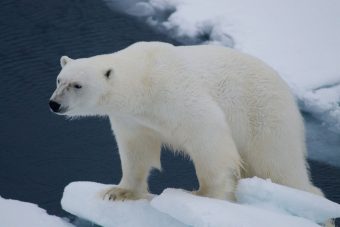Record absence of ice after freak warm spells denies pregnant bears birthing dens and triggers ‘extirpation event’ warning.

A record slow freeze of many regions of the Arctic this winter is making it harder for pregnant polar bears to find birthing dens.
The delayed formation of sea ice during autumn has worried biologists, who fear a first “extirpation event” – the local extinction of a species – may be approaching faster than forecast for the most affected populations.
The waters around Svalbard, an archipelago between Norway and the North Pole, have a little over half the average area of ice for this time of year. According to the Norwegian Ice Service, the 172,291 sq km (66,522 sq m) of ice on 14 November was the lowest for this time of year since records began in 1967.
October also saw a huge departure from previous trends, particularly in the Barents Sea, which had freakishly warm weather in February and August. Scientists say these shifts, which are caused by the manmade heating of the globe, are disrupting the behaviour of species that depend on thick winter ice, such as narwhals, seals, belugas and polar bears.
“We’re restructuring a whole ecosystem. Sea ice is to the Arctic what soil is to the forest. Without sea ice we’ll still have an ecosystem but it won’t include polar bears & many other species,” tweeted the scientist Andrew Derocher, who has studied the bears for 35 years.
“It’s sounds like a broken record, reporting record-breaking low sea ice cover in Svalbard. This area has warmed dramatically in recent years. Polar bears here may be the first extirpation event,” he wrote, though he noted that so far the problem was restricted to habitat loss.
One of 19 polar bear populations in the Arctic, Svalbard has close to 2,500 individual bears. This number has been stable for the past 15 years, but pressures are growing.
Because of the delay in ice formation, bears have to wait longer to hunt for seals, which means they are missing out on an autumn feeding season that is important for them to build up fat.
A recent study showed bears survived previous warm periods by gorging on beached whales, but this was unlikely to be enough to cope with the current pace of climate change.
Although there has been some ice formation in recent days, it was still the second lowest on record on Thursday.
The most immediate concern is for pregnant females, who normally travel across the ice at this time to make maternity dens on Hopen and other islands that are important for reproduction, said Jon Aars of the Norwegian Polar Institute.
“Unless sea ice forms within the next few weeks, pregnant females will have to swim,” he said, noting this uses five times as much energy and runs down fat reserves that are important for producing milk and raising cubs.
Previous research in other Arctic regions have shown that pregnant females declined in weight and litter sizes went down from 1.8 to 1.6 between 1993 and 2017.
Aars said if current climate trends continued bears would struggle, although it was hard to say when the tipping point would be.
“In 2000, we didn’t foresee that Svalbard would be ice-free at this time of the year,” he said. “If this continues, there’ll be a threshold where it will be hard for the bears to reproduce. Things can happen fast. I’m not optimistic about whether the bears will survive. If the sea ice disappears, then so will the bears.”
Source: The Guardian

